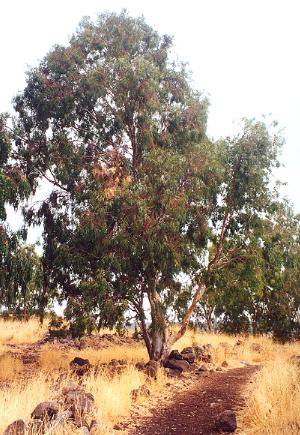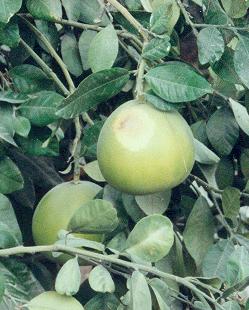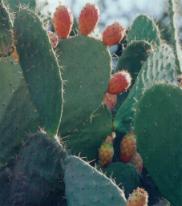
Eucalyptus in northern Israel
 Eucalyptus in northern Israel |
Many new plants introduced to the Israeli landscape, in particular during the last 150 years or so. Some were brought over to combat desertification and prevent soil erosion, others have been imported or developed by Israel's innovative agricultural sector. Still more have been "accidentals" which have arrived with ships or visitors and have successfully taken root here.
More usually associated with Australia than with Israel, the eucalyptus was until the early 1960s one of the most commonly planted trees in Israel. It was introduced in the late nineteenth century to drain swampland in northern Israel. The tree is common in many parts of northern and central Israel, usually growing by water sources or roads. It is one of Israel's most important sources of wood.
Another Aussie native which has made itself at home in Israel is acacia saligna (cyanphylla) planted originally in the sand dunes of the north-west Negev and coastal regions to prevent soil erosion and later in other arid regions of the country as part of Israel's reforestation projects, this acacia is now widespread throughout the country, growing by roadsides, on wasteland and in many parks and gardens, brightening the landscape with its vibrant yellow blooms. This Australian acacia belongs to a different acacia sub-species from its native Israeli cousins.
Citrus
 Pomelos on the tree |
Israel's famous citrus fruits, including the Jaffa orange, are not native to the region, though the first citrus were introduced thousands of years ago. The modern sweet orange probably only arrived about 500 or 600 years ago from the Iberian peninsular. British Philanthropist Sir Moses Montifiore helped to found the modern Israeli citrus industry in the mid-19th century when he purchased land on the outskirts of the port city of Jaffa, planting orange orchards.
Today the burgeoning metropolis of Tel-Aviv-Jaffa has covered the orchards, but go a few kilometres east of the city and you can still see citrus groves near Ben-Gurion airport. The fate of the Jaffa orchards has been repeated all along the coastal plains, with formerly agricultural towns such as Ra'anana, Giva'tayim and Petah Tikva also swallowing up their organges as new neighbourhoods go up.
There are still many farms producing the fruit though and citrus production remains about 6% of Israeli agricultural production, including several varieties of oranges, lemons, pomelo, grapefruit and kuamquats.
 Banana tree in Modi'in |
Bananas, Mangos and more...
Israel is perhaps not a country you associate with bananas, though they are quite common here, grown mostly for domestic consumption rather than export. Drive through parts of the northern coast, Jordan Valley or the shores of the Sea of Galilee and you'll pass large plantations, often right by the road or railway tracks. Many people grow them in private gardens as well, in particular for their gigantic, alien looking flowers.
Mango and avocado groves are also quite common in Israel, and both have become premier export crops, with Israeli growers becoming well known internationally for the top quality of their produce.
Other fruits introduced in recent decades and now grown commercially and in gardens all over Israel include loquat, papaya, passionfruit, kiwi and blueberries.
Sabra Prickly Pears and Latin American cacti
 Sabra fruit (prickly pears) |
The most well entrenched newcomer is the Sabra cactus (prickly pear) which now grows wild in many parts of the country, though it is originally a native of Mexico and the American south west which only arrived in Israel in the late nineteenth century. It is common in most parts of Israel and several varieties are grown here, including some without prickles. Their fruit is widely sold in supermarkets and roadside stalls during the summer.
With the declining profitability of citrus production and rising water costs many Israeli farmers have been turning to more "exotic" fruits. Newer crops include the koubo, a cactus fruit originally from Latin America. Israeli researchers have developed the first commercially viable strain of koubo which they've introduced to the local market in a few years ago. They taste a little like pitaya, another Latin American cactus fruit recently introduced to Israel. The latest Israeli innovation in the field are "dragon eggs" a cross between different types of pitaya engineered at a Ben-Gurion University research centre in the Negev desert.
Introduction to Israeli Flora |
Plants of the Bible |
More Plants of the Bible and Talmud |
Israeli botanical and nature links
Introduced species |
Trees and Flowers in the Modi'in area |
Copyright 2003 by Leiah Elbaum. Text and illustrations on this page are by Leiah Elbaum. Last updated 8 April 2003.